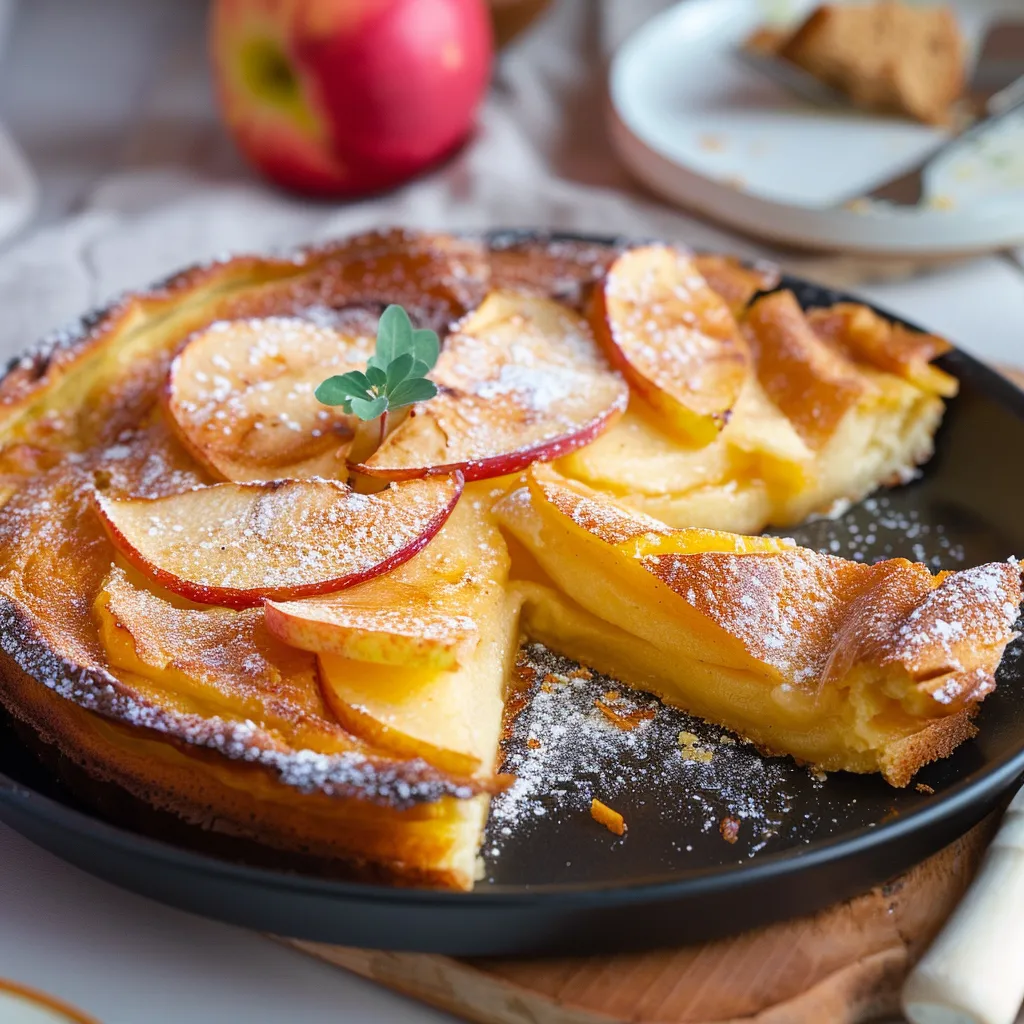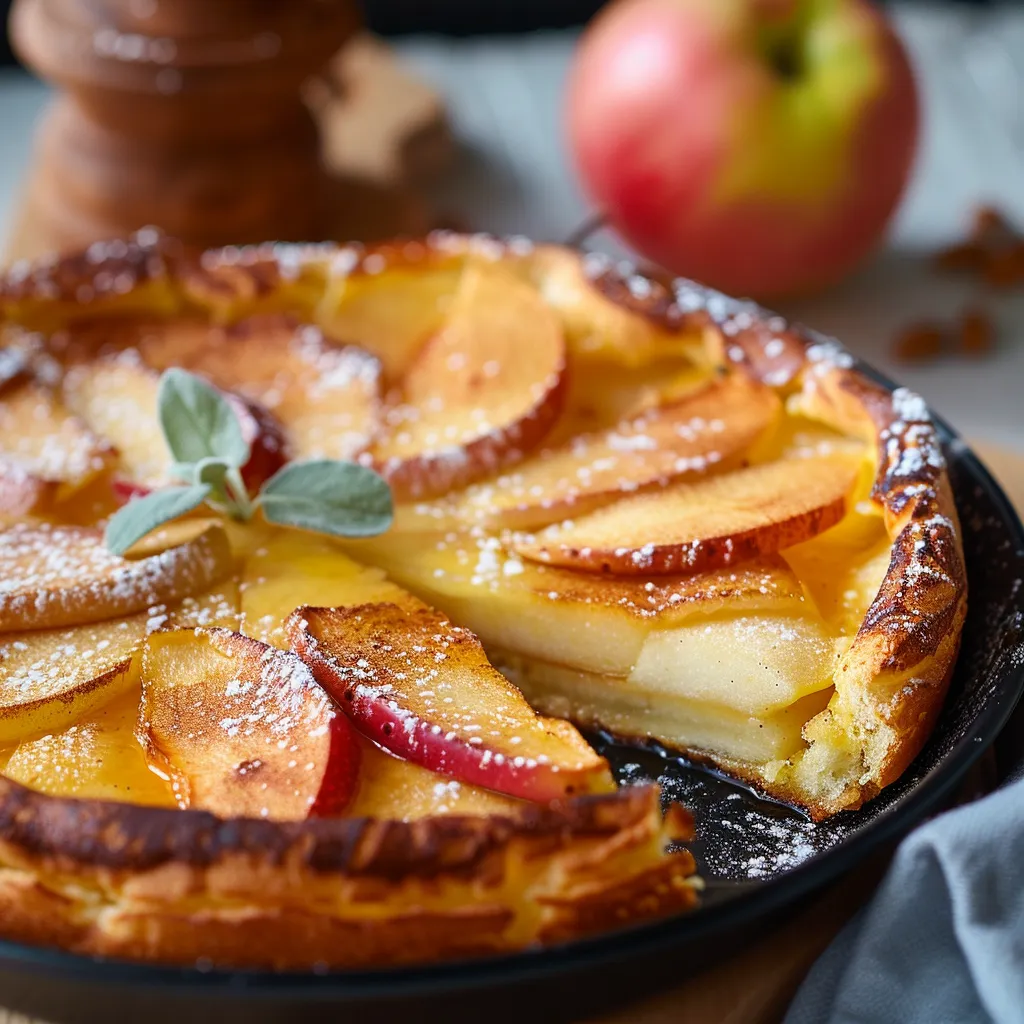 Pin it
Pin it
This German Apple Pancake, also known as Apple Dutch Baby, transforms ordinary breakfast into something spectacular with its dramatically puffed edges and custardy center filled with caramelized cinnamon apples. The pancake rises impressively in the oven before settling into a rustic, cratered landscape that begs to be showered with powdered sugar or a drizzle of maple syrup.
I first made this on a lazy Sunday morning when my family was craving something special but I wasn't in the mood for the usual pancake flipping routine. The oohs and aahs when I pulled this golden puffed creation from the oven made it an instant tradition in our home.
Key Ingredients
- Large eggs: Provide the structure that creates that dramatic rise and custardy interior
- All purpose flour: Should be properly measured by spooning into your measuring cup rather than scooping
- Milk: Creates richness and helps develop the perfect texture
- Vanilla extract: Adds warmth to both the batter and apples
- Fresh apples: Work best here though any variety will do
- Butter: Essential for both cooking the apples and creating those crispy edges
- Cinnamon: Brings warmth and that classic apple pie flavor
- Lemon juice: Brightens the apple flavor and prevents browning
- Sugar: Just enough to enhance the natural sweetness of the apples
Step-by-Step Instructions
- Preheat Oven and Baking Dish:
- Place your baking dish or skillet in the oven while preheating to 425°F. This crucial step ensures the batter hits a hot surface, creating that dramatic puff. A cast iron skillet works beautifully but any oven safe dish will do. Allow at least 10 minutes for proper preheating.
- Prepare The Batter:
- For smoothest results use a blender to combine eggs, flour, sugar, vanilla, salt and milk. Blend for about 30 seconds until completely smooth. If mixing by hand whisk eggs, flour, sugar, vanilla and salt first until smooth, then gradually incorporate milk. The batter should be thin and pourable without lumps.
- Prepare And Cook Apples:
- Peel and slice apples into uniform pieces about 1/4 inch thick. Heat butter in a large frying pan until foaming subsides. Add apples in an even layer and let them brown undisturbed for 2 minutes. This develops caramelization and depth of flavor. Add sugar, vanilla, lemon juice and cinnamon, then stir occasionally until apples soften slightly with some golden edges.
- Assemble And Bake:
- Remove the preheated baking dish from oven carefully using thick mitts. Add butter and swirl to coat entire surface including sides. Quickly arrange cooked apples in an even layer then pour batter over top. Immediately return to oven and bake about 15 minutes until dramatically puffed and golden brown around edges.
- Serve Immediately:
- The pancake will begin deflating as soon as it leaves the oven this is completely normal. Slice into wedges while still warm and serve with toppings of choice. The contrast between the crisp edges and soft center creates a delightful textural experience.
 Pin it
Pin it
This recipe reminds me of my grandmother who always insisted that properly browning the apples was the difference between a good Dutch baby and a great one. She would stand over the stove waiting for that perfect caramelization before declaring them ready. That extra patience makes all the difference in the final flavor.
Make Ahead Options
While this pancake is best enjoyed fresh from the oven, you can prepare elements ahead of time to streamline your morning. Mix the batter the night before and refrigerate in a covered container. In the morning, simply give it a quick whisk while the oven preheats. You can also cook the apples in advance and gently reheat them before assembling the pancake. This preparation makes it perfect for holiday breakfasts when kitchen efficiency matters.
Seasonal Variations
The beauty of this German pancake lies in its adaptability. In summer, substitute fresh berries or peaches for the apples. In autumn, try pears with a sprinkle of cardamom. Winter calls for cranberries with orange zest, while spring welcomes rhubarb with a touch more sugar. The basic batter remains unchanged while the filling celebrates the best produce of the season, making this recipe a year round staple.
Serving Suggestions
While delicious on its own, this pancake reaches new heights with thoughtful accompaniments. A dusting of powdered sugar creates a snow covered landscape that delights children and adults alike. For special occasions, serve with a scoop of vanilla ice cream or freshly whipped cream. A drizzle of pure maple syrup or honey adds sweetness, while a dollop of Greek yogurt provides a tangy contrast to the sweet apples. For brunch gatherings, pair with crispy bacon or breakfast sausage for a sweet and savory combination.
Traditional Context
The Dutch Baby has roots in German cuisine, specifically from a dish called "Apfelpfannkuchen." German immigrants brought this recipe to America where it evolved into what we now call a Dutch Baby, likely a mispronunciation of "Deutsch" meaning German. In Germany, similar pancakes are traditionally served as a special breakfast or light dinner option. Unlike American pancakes cooked individually on a griddle, this version is baked whole, creating its distinctive puffed appearance and simplifying the cooking process.
 Pin it
Pin it
Frequently Asked Questions
- → What type of apples should I use?
Choose firm apples such as Granny Smith or Honeycrisp, as they hold their shape and balance the sweetness of the pancake well.
- → Can I use a cast-iron skillet?
Absolutely! A cast-iron skillet works great for making this dish. Be sure to heat it in the oven before adding butter and batter for the best puff.
- → How can I prevent the pancake from sticking?
Ensure your baking dish or skillet is properly preheated and well-buttered, especially on the edges, to prevent sticking.
- → Can this dish be made ahead of time?
This pancake is best served immediately after baking, as it deflates over time. Prepare the batter in advance but cook right before serving.
- → Can I substitute the milk?
Yes, you can use a non-dairy milk like almond or oat milk as a substitute for regular milk without altering the recipe much.
